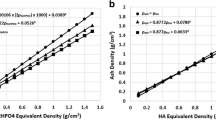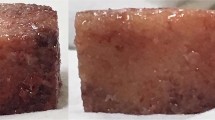Abstract
This study aims to examine agreement among bone mineral content (BMC) and density (BMD) estimates obtained using dual-energy X-ray absorptiometry (DXA), peripheral quantitative computed tomography (pQCT), and micro-computed tomography (μCT) against high-resolution μCT and bone ash of the guinea pig femur. Middle-aged (n = 40, 86 weeks) male guinea pigs underwent in vivo followed by ex vivo DXA (Hologic QDR 4500A) scanning for intact and excised femur BMC and areal density. To assess bone architecture and strength, excised femurs were scanned on pQCT (Stratec XCT 2000L) as well as on two μCT scanners (LaTheta LCT-200; Skyscan 1174), followed by three-point bending test. Reproducibility was determined using triplicate scans; and agreement assessed using Bland–Altman plots with reference methods being high-resolution μCT (Skyscan) for BMD and bone ashing for BMC. All techniques showed satisfactory ex vivo precision (CV 0.05–4.3 %). However, bias compared to the reference method was highest (207.5 %) in trabecular bone volume fraction (BV/TV) measured by LaTheta, and unacceptable in most total femur and cortical bone measurements. Volumetric BMD (vBMD) and BV/TV derived by LaTheta and pQCT at the distal metaphysis were biased from the Skyscan by an average of 49.3 and 207.5 %, respectively. Variability of vBMD, BV/TV and cross-sectional area at the diaphysis ranged from −5.5 to 30.8 %. LaTheta best quantified total femur BMC with an upper bias of 3.3 %. The observed differences among imaging techniques can be attributable to inherent dissimilarity in construction design, calibration, segmentation and scanning resolution used. These bone imaging tools are precise but are not comparable, at least when assessing guinea pig bones.




Similar content being viewed by others
References
Binkley N, Dahl D, Engelke J, Kawahara-Baccus T, Krueger D, Colman R (2003) Bone loss detection in rats using a mouse densitometer. J Bone Miner Res 18:370–375
Brochmann EJ, Duarte ME, Zaidi HA, Murray SS (2003) Effects of dietary restriction on total body, femoral, and vertebral bone in SENCAR, C57BL/6, and DBA/2 mice. Metabolism 52:1265–1273
Iida-Klein A, Lu SS, Cosman F, Lindsay R, Dempster DW (2007) Effects of cyclic vs. daily treatment with human parathyroid hormone (1–34) on murine bone structure and cellular activity. Bone 40:391–398
Klein RF, Shea M, Gunness ME, Pelz GB, Belknap JK, Orwoll ES (2001) Phenotypic characterization of mice bred for high and low peak bone mass. J Bone Miner Res 16:63–71
Bouxsein ML, Boyd SK, Christiansen BA, Guldberg RE, Jepsen KJ, Müller R (2010) Guidelines for assessment of bone microstructure in rodents using micro-computed tomography. J Bone Miner Res 25:1468–1486
Muraoka T, Hagino H, Okano T, Enokida M, Teshima R (2007) Role of subchondral bone in osteoarthritis development: a comparative study of two strains of guinea pigs with and without spontaneously occurring osteoarthritis. Arthritis Rheum 56:3366–3374
Lochmüller E, Jung V, Weusten A, Wehr U, Wolf E, Eckstein F (2001) Precision of high-resolution dual energy X-ray absorptiometry measurements of bone mineral status and body composition in small animal models. Eur Cells Mater 1:43–51
Iida-Klein A, Lu SS, Yokoyama K, Dempster DW, Nieves JW, Lindsay R (2003) Precision, accuracy, and reproducibility of dual X-ray absorptiometry measurements in mice in vivo. J Clin Densitom 6:25–33
Schmidt C, Priemel M, Kohler T, Weusten A, Müller R, Amling M, Eckstein F (2003) Precision and accuracy of peripheral quantitative computed tomography (pQCT) in the mouse skeleton compared with histology and microcomputed tomography (μCT). J Bone Miner Res 18:1486–1496
Müller R, Hildebrand T, Häuselmann H, Rüegsegger P (1996) In vivo reproducibility of three-dimensional structural properties of noninvasive bone biopsies using 3D-pQCT. J Bone Miner Res 11:1745–1750
Kohler T, Beyeler M, Webster D, Müller R (2005) Compartmental bone morphometry in the mouse femur: reproducibility and resolution dependence of microtomographic measurements. Calcif Tissue Int 77:281–290
Barou O, Valentin D, Vico L, Tirode C, Barbier A, Alexandre C, Lafage-Proust MH (2002) High-resolution three-dimensional micro-computed tomography detects bone loss and changes in trabecular architecture early: comparison with DEXA and bone histomorphometry in a rat model of disuse osteoporosis. Investig Radiol 37:40–46
Libouban H, Moreau M-F, Legrand E, Baslé MF, Audran M, Chappard D (2001) Comparison insight dual X-ray absorptiometry (DXA), histomorphometry, ash weight, and morphometric indices for bone evaluation in an animal model (the orchidectomized rat) of male osteoporosis. Calcif Tissue Int 68:31–37
Fink C, Cooper H, Huebner J, Guilak F, Kraus V (2002) Precision and accuracy of a transportable dual-energy X-ray absorptiometry unit for bone mineral measurements in guinea pigs. Calcif Tissue Int 70:164–169
DeGuire JR, Mak IL, Lavery P, Agellon S, Wykes LJ, Weiler HA (2014) Orchidectomy-induced alterations in volumetric bone density, cortical porosity and strength of femur are attenuated by dietary conjugated linoleic acid in aged guinea pigs. Bone 73:42–50
Subcommittee on Laboratory Animal Nutrition. Committee on Animal Nutrition, Board on Agricultural, and National Research Council (1995) Nutrient requirements of laboratory animals, 4th revised edn. National Academy Press, Washington, DC
Canadian Council on Animal Care (1996) Guide to the care and use of experimental animals, 2nd edn. The Canadian Council on Animal Care, Ottawa
Meganck JA, Kozloff KM, Thornton MM, Broski SM, Goldstein SA (2009) Beam hardening artifacts in micro-computed tomography scanning can be reduced by X-ray beam filtration and the resulting images can be used to accurately measure BMD. Bone 45:1104–1116
Sijbers J, Postnov A (2004) Reduction of ring artefacts in high resolution micro-CT reconstructions. Phys Med Biol 49:N247–N253
Turner CH, Burr DB (1993) Basic biomechanical measurements of bone: a tutorial. Bone 14:595–608
Bland JM, Altman DG (1986) Statistical methods for assessing agreement between two methods of clinical measurement. Lancet 327:307–310
Bland JM, Altman DG (1995) Comparing methods of measurement: why plotting difference against standard method is misleading. Lancet 346:1085–1087
Critchley LA (2011) Validation of the MostCare pulse contour cardiac output monitor: beyond the Bland and Altman plot. Anesth Analg 113:1292–1294
Petersen PH, Stöckl D, Blaabjerg O, Pedersen B, Birkemose E, Thienpont L, Lassen JF, Kjeldsen J (1997) Graphical interpretation of analytical data from comparison of a field method with a reference method by use of difference plots. Clin Chem 43:2039–2046
Holdsworth DW, Thornton MM (2002) Micro-CT in small animal and specimen imaging. Trends Biotechnol 20:S34–S39
Laperre K, Depypere M, van Gastel N, Torrekens S, Moermans K, Bogaerts R, Maes F, Carmeliet G (2011) Development of micro-CT protocols for in vivo follow-up of mouse bone architecture without major radiation side effects. Bone 49:613–622
Brodt M, Pelz G, Taniguchi J, Silva M (2003) Accuracy of peripheral quantitative computed tomography (pQCT) for assessing area and density of mouse cortical bone. Calcif Tissue Int 73:411–418
Hara T, Tanck E, Homminga J, Huiskes R (2002) The influence of microcomputed tomography threshold variations on the assessment of structural and mechanical trabecular bone properties. Bone 31:107–109
Burghardt AJ, Kazakia GJ, Majumdar S (2007) A local adaptive threshold strategy for high resolution peripheral quantitative computed tomography of trabecular bone. Ann Biomed Eng 35:1678–1686
Cordey J, Schneider M, Belendez C, Ziegler WJ, Rahn BA, Perren SM (1992) Effect of bone size, not density, on the stiffness of the proximal part of normal and osteoporotic human femora. J Bone Miner Res 7:S437–S444
Ferretti JL, Capozza RF, Mondelo N, Zanchetta JR (1993) Interrelationships between densitometric, geometric, and mechanical properties of rat femora: inferences concerning mechanical regulation of bone modeling. J Bone Miner Res 8:1389–1396
Beck TJ, Ruff CB, Warden KE, Scott WW Jr, Rao GU (1990) Predicting femoral neck strength from bone mineral data: a structural approach. Investig Radiol 25:6–18
Yeni Y, Brown C, Wang Z, Norman T (1997) The influence of bone morphology on fracture toughness of the human femur and tibia. Bone 21:453–459
Wang X, Masilamani N, Mabrey J, Alder M, Agrawal C (1998) Changes in the fracture toughness of bone may not be reflected in its mineral density, porosity, and tensile properties. Bone 23:67–72
Martin R, Ishida J (1989) The relative effects of collagen fiber orientation, porosity, density, and mineralization on bone strength. J Biomech 22:419–426
Ferretti J (1995) Perspectives of pQCT technology associated to biomechanical studies in skeletal research employing rat models. Bone 17:S353–S364
Currey J (1969) The mechanical consequences of variation in the mineral content of bone. J Biomech 2:1–11
Currey J (1975) The effects of strain rate, reconstruction and mineral content on some mechanical properties of bovine bone. J Biomech 8:81–86
Currey JD (1988) The effect of porosity and mineral content on the Young’s modulus of elasticity of compact bone. J Biomech 21:131–139
Sottile V, Seuwen K, Kneissel M (2004) Enhanced marrow adipogenesis and bone resorption in estrogen-deprived rats treated with the PPARγ agonist BRL49653 (rosiglitazone). Calcif Tissue Int 75:329–337
Müller R, Van Campenhout H, Van Damme B, Van der Perre G, Dequeker J, Hildebrand T, Rüegsegger P (1998) Morphometric analysis of human bone biopsies: a quantitative structural comparison of histological sections and micro-computed tomography. Bone 23:59–66
Acknowledgments
The authors would like to thank Dr. T. Hazell and Mrs. C. Vanstone for technical assistance with the pQCT.
Conflict of interest
The authors report no conflict of interests.
Author information
Authors and Affiliations
Corresponding author
Electronic supplementary material
Below is the link to the electronic supplementary material.
774_2015_675_MOESM1_ESM.docx
Supplementary Fig. 1 shows effects of altering the peripheral quantitative computed tomography (pQCT) attenuation threshold on segmentation within the bone. Threshold values are chosen based on pQCT results that approach Skyscan values. Inner threshold (I. threshold) in CALCBD contour mode 1, peel mode 2 (C1/P2), was altered at the distal metaphysis; using the same algorithm at the proximal diaphysis both inner and attenuation threshold were manipulated. (DOCX 389 kb)
About this article
Cite this article
Mak, I.L., DeGuire, J.R., Lavery, P. et al. Dual-energy X-ray absorptiometry, peripheral quantitative computed tomography, and micro-computed tomography techniques are discordant for bone density and geometry measurements in the guinea pig. J Bone Miner Metab 34, 266–276 (2016). https://doi.org/10.1007/s00774-015-0675-1
Received:
Accepted:
Published:
Issue Date:
DOI: https://doi.org/10.1007/s00774-015-0675-1




